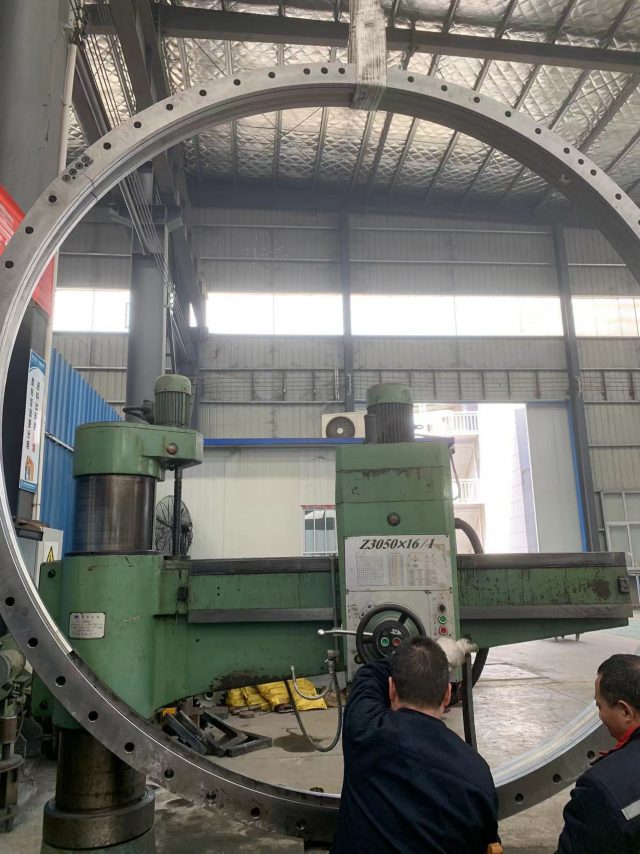slewing ring bearing for sale
1.Advantages of slewing ring bearing grinding
The advantages of slewing ring bearing grinding: reduce meshing impact, vibration and noise and wear, improve meshing accuracy, transmit torque smoothly, improve life, and reduce accumulated errors.
Four Requirements for Gear Transmission Accuracy
1. The accuracy of the transmission movement. It is required that the angle error of the gear in one revolution is limited within a certain range, so that the change of the transmission ratio of the gear pair is small, so as to ensure the accurate transmission movement.
2. The stability of the transmission movement. It is required that the angle error within the range of one tooth of the gear is limited within a certain range, so that the change of the instantaneous transmission ratio of the gear pair is small, so as to ensure the stability of the transmission and reduce vibration, impact and noise.
3. The uniformity of load distribution. It is required that the working tooth surfaces in the transmission have good contact to ensure uniform load distribution, otherwise it will cause stress concentration on the tooth surface, premature wear and reduce service life.
4. The rationality of the transmission backlash. It is required to leave a certain backlash between the non-working tooth surfaces of the meshing gear teeth in order to store the lubricating oil, compensate for elastic deformation and thermal deformation and the manufacturing and installation errors of the gear.

2.The role of spacers and cages for slewing ring bearings
The spacer and cage of the slewing ring bearing and the slewing bearing are expressed as spacer and CAGE in English. Their main functions can be summed up in a word, reducing friction, coordinating the operation efficiency, distributing the load, and guiding the circumferential trajectory of the rolling elements. It is an integral part of the overall design of the bearing.
Cage (that is, bearing cage, also known as bearing cage, foreign name: cage), refers to the bearing parts that partially wrap all or part of the rolling body and move with it, to isolate the rolling body, and usually guide the rolling body and keep it in the bearing.
2 Main functions 1. Keep a proper distance between the rolling elements to prevent the rolling elements from contacting each other to reduce friction; 2. Make the rolling elements evenly distributed, so that the load is evenly distributed;
3. Guide the rolling elements in the no-load area to improve the bearing rolling condition to prevent damaging slippage. The cage must withstand the stress caused by friction, strain and inertial force, and also withstand the chemical corrosion of lubricants, additives in lubricants or substances generated by their aging, organic solvents or coolants. Therefore, the design and material of the cage are extremely important for its performance and the reliability of the bearing.
3 types of cages Bearing cages are divided into stamping cages (Figure 1), solid cages (Figure 2) and strut cages 1. The advantages of stamping cages are light weight and large internal space, which can facilitate the entry of lubricants ; 2. The solid cage is usually allowed to have a higher speed. When the bearing has other forms of motion other than rotation at the same time, especially in the case of high speed, the machined metal cage should also be used;
3. The pillar cage is penetrated by pins Roller with perforations to secure both ends of the pin to the washer. This cage is lighter in weight and can accommodate more rollers and is only used in oversized roller bearings.
4. Cage materials Cage materials mainly include stamping steel, machined steel, stamped brass, machined brass, polymeric materials, etc. Stamped steel cages have high strength and can be surface treated to reduce friction and wear; machined steel cages are generally used for oversized bearings or where brass cages are not suitable; stamped brass cages are used in part Small bearings;
Machined brass cages are generally not affected by bearing lubricants and can be cleaned with ordinary lubricants. Brass cages should not be used for operating temperatures above 250; Polymeric material (nylon 66, nylon 46, etc.) cages Compared with metal cages, it has many advantages such as good toughness, friction and wear resistance, impact resistance, acid resistance and corrosion resistance.

